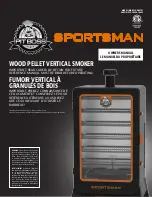
3
I56-3433-004
04-12
In a room with a smooth ceiling, detectors should be spaced between 30 and
60 feet (9.1 to 18.3 m). One-half that spacing between the beam and the side-
wall may be used as a guide. See Figure 1. The beam detector can be mounted
with the transmitter/receiver on one wall and the reflector on the opposite
wall, or both suspended from the ceiling, or any wall/ceiling combination.
In the case of the ceiling mount, the distance from the end walls should not
exceed one-quarter of the selected spacing (7.5 ft. [2.3 m] maximum if the
spacing is 30 ft. [9.1 m] ). See Figure 2.
FIGURE 1. SPACING FOR SMOOTH CEILING (SIDE VIEW):
1
/
2
S
S
12 - 18 IN.
(0.3 - 0.46M)
WALL
C0254-00
FIGURE 2. SPACING FOR SMOOTH CEILING (TOP VIEW):
16 FT. (5M) MINIMUM
328 FT. (100M) MAXIMUM
Tx/Rx
REFLECTOR
S
Tx/Rx
REFLECTOR
1
/
2
S MAXIMUM
1
/
4
S
MAX.
C0255-00
In the case of peaked or sloped ceilings, codes may specify spacing of detec-
tors by using horizontal spacing from the peak of the roof or ceiling. Figures
3 and 4 show the spacing for both the shed type and peaked type sloped
ceilings.
On smooth ceilings, beam smoke detectors should generally be mounted be-
tween 12 and 18 inches (0.3 to 0.46 m) from the ceiling. In many cases, how-
ever, the location and sensitivity of the detectors shall be the result of an
engineering evaluation that includes the following: structural features, size
and shape of the room and bays, occupancy and uses of the area, ceiling
height, ceiling shape, surface and obstructions, ventilation, ambient environ-
ment, burning characteristics of the combustible materials present, and the
configuration of the contents in the area to be protected. As a general rule,
reflective objects such as ductwork or windows should be a minimum of 15
inches (38.1 cm) from the path of the beam.
FIGURE 3. SLOPED CEILING (SHED TYPE):
S
3 FT.
(0.9M)MAX.
S
1
/
2
S MAX.
Tx/Rx
REFLECTOR
C0256-00
FIGURE 4. SLOPED CEILING (PEAKED TYPE):
1
/
2
S
S
S
1
/
2
S
3 FT. (0.9M)
MAX.
3 FT. (0.9M)
MAX.
MOUNT SPOT DETECTOR
ANYWHERE IN THIS
AREA AT LEAST 4 IN. (100 mm)
VERTICALLY FROM PEAK
Tx/Rx
REFLECTOR
C0257-04
MOUNTING LOCATIONS
Beam detectors require a stable mounting surface for proper operation. A sur-
face that moves, shifts, vibrates, or warps over time will cause false alarm or
trouble conditions. Initial selection of a proper mounting surface will elimi-
nate false alarms and nuisance trouble signals.
Mount the detector on a stable mounting surface, such as brick, concrete,
a sturdy load-bearing wall, support column, structural beam, or other sur-
face that is not expected to experience vibration or movement over time. DO
NOT MOUNT the beam detector on corrugated metal walls, sheet metal walls,
external building sheathing, external siding, suspended ceilings, steel web
trusses, rafters, nonstructural beam, joists, or other such surfaces.
In cases where only one stable mounting surface as defined above can be
used, the transmitter/receiver unit should be mounted to the stable surface
and the reflector should be mounted to the less stable surface. The reflec-
tor has a much greater tolerance for the unstable mounting locations defined
above.
MOUNTING INSTRUCTIONS
The transmitter/receiver unit may be mounted over a recessed junction box.
The cavity behind the detector is then used for routing of the wiring from the
junction box to the terminal blocks on the detector. The transmitter/receiver
unit should be mounted to the wall such that unit covers the recessed junc-
tion box in the wall completely. If the junction box is not recessed then you
may use the surface mount kit (BEAMSMK). See the BEAMSMK installation
instructions for surface mounting instructions. The transmitter/receiver unit
can be mounted to the wall using the supplied drilling template (see Appendix
II). The detector base has 4 primary mounting keyholes, one in each corner of
the base. All four hole locations should be used to provide a secure mounting.
The outer housing of the beam detector is held to the base using four screws.
In order to mount the detector you must remove the outer housing first.
The reflector can be mounted to the wall using the supplied drilling template
(see Appendix III). The reflector has 4 mounting holes, one in each corner.
All four hole locations should be used to provide a secure mounting. The
reflector must be mounted such that it is within 10° in both the X and Y
planes of the transmitter/receiver unit. See Figure 5a. The reflector must also
be mounted such that the plane of the reflector is perpendicular to the optical
Содержание SK-Beam
Страница 10: ...10 I56 3433 004 04 12 ...
Страница 11: ...11 I56 3433 004 04 12 APPENDIX II DETECTOR DRILLING TEMPLATE 4 345 6 190 157 mm 110 mm Scale 1 1 C0278 00 ...
Страница 12: ...12 I56 3433 004 04 12 ...
Страница 13: ...13 I56 3433 004 04 12 APPENDIX III REFLECTOR DRILLING TEMPLATE 5 512 140mm 8 465 215mm Scale 1 1 C0279 00 ...
































